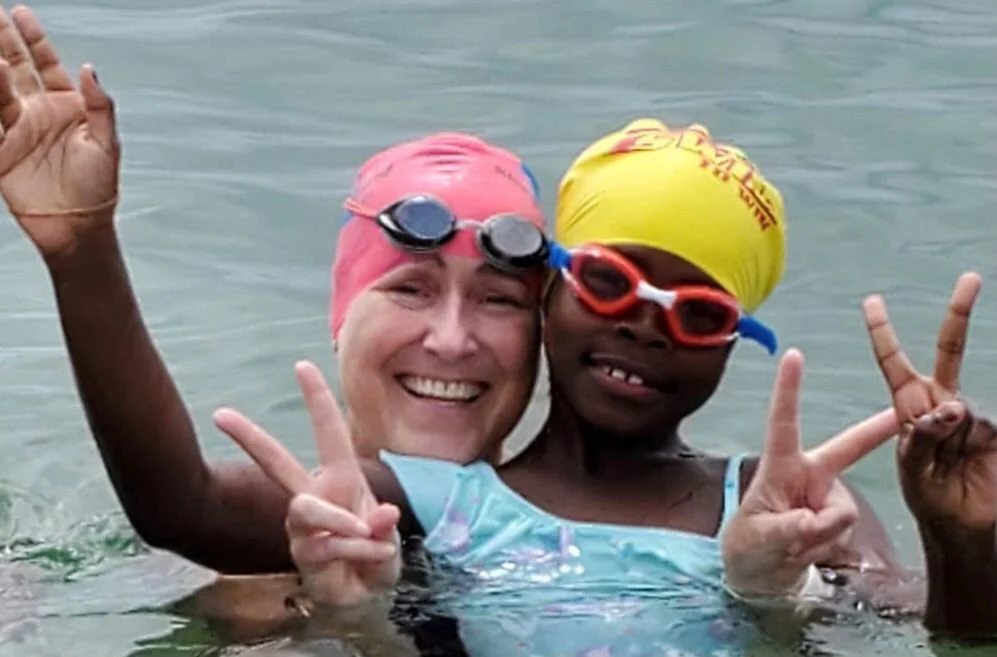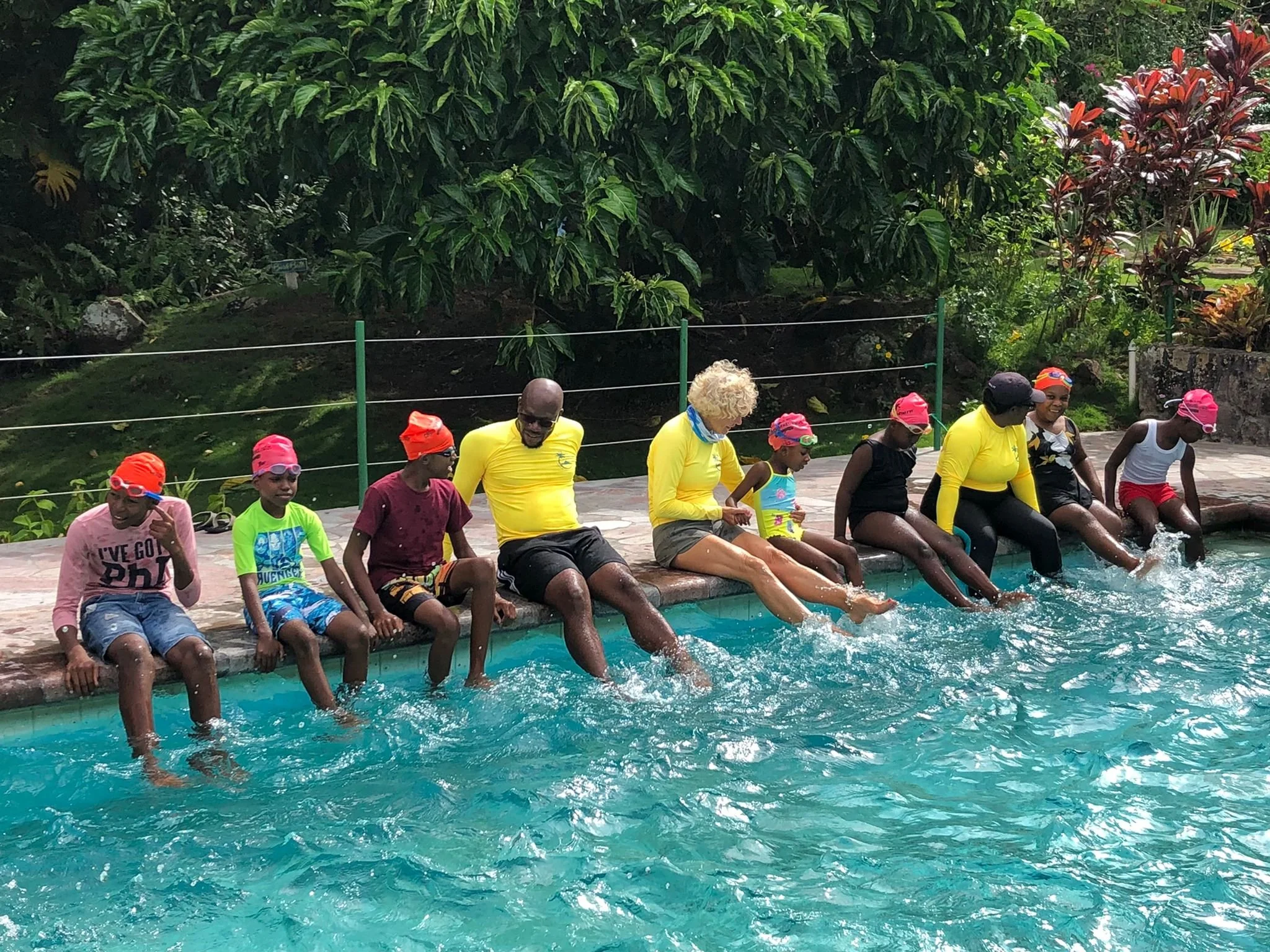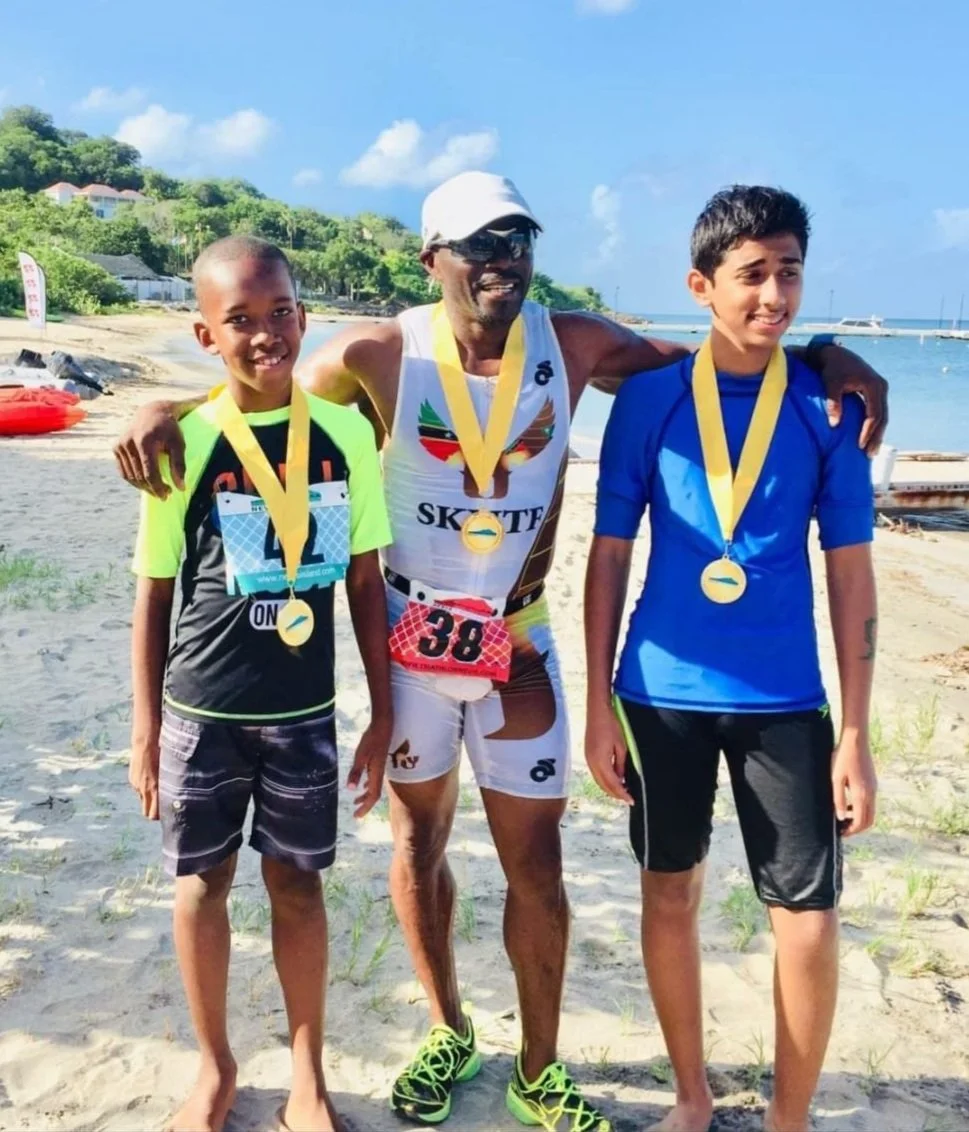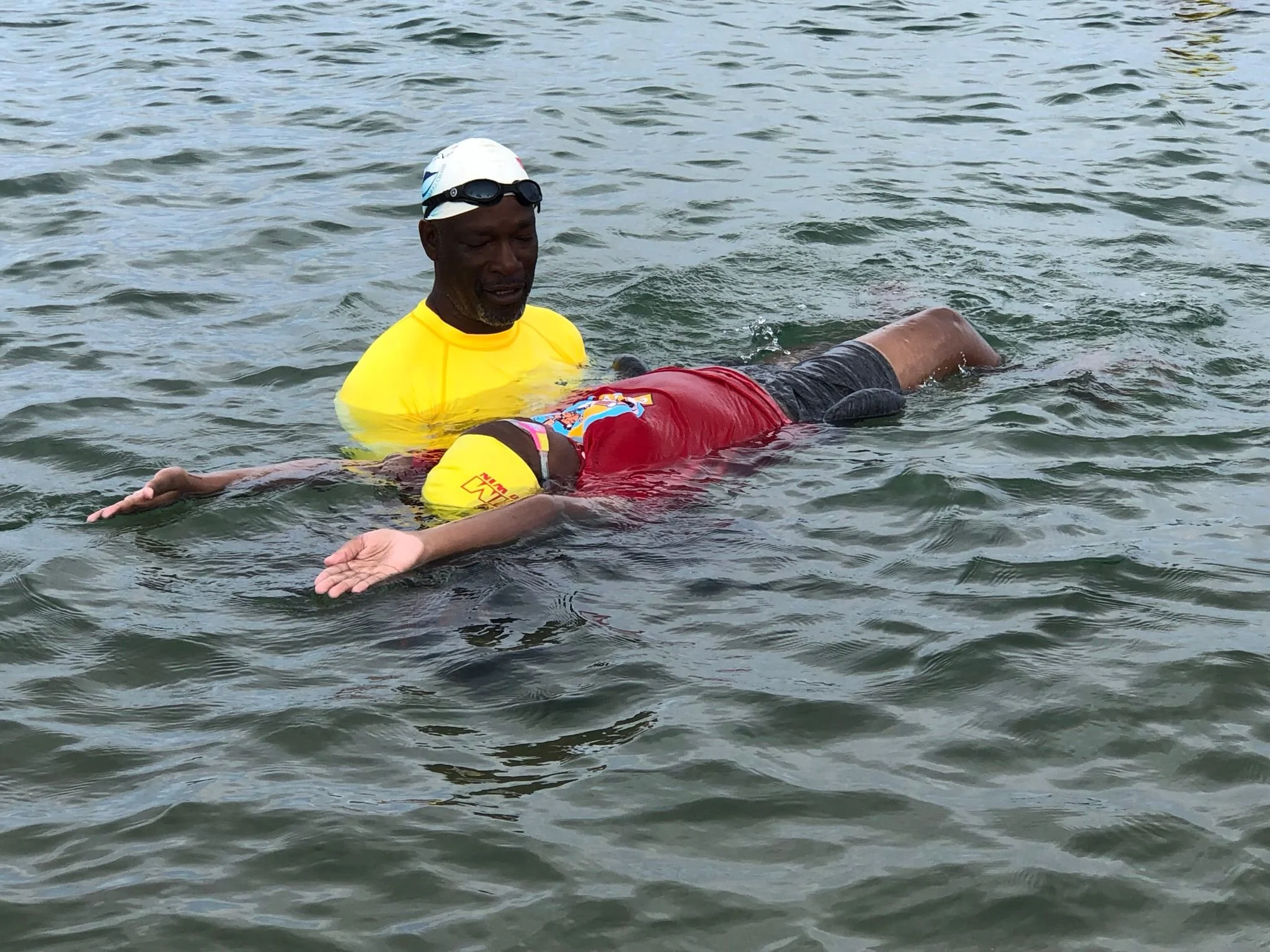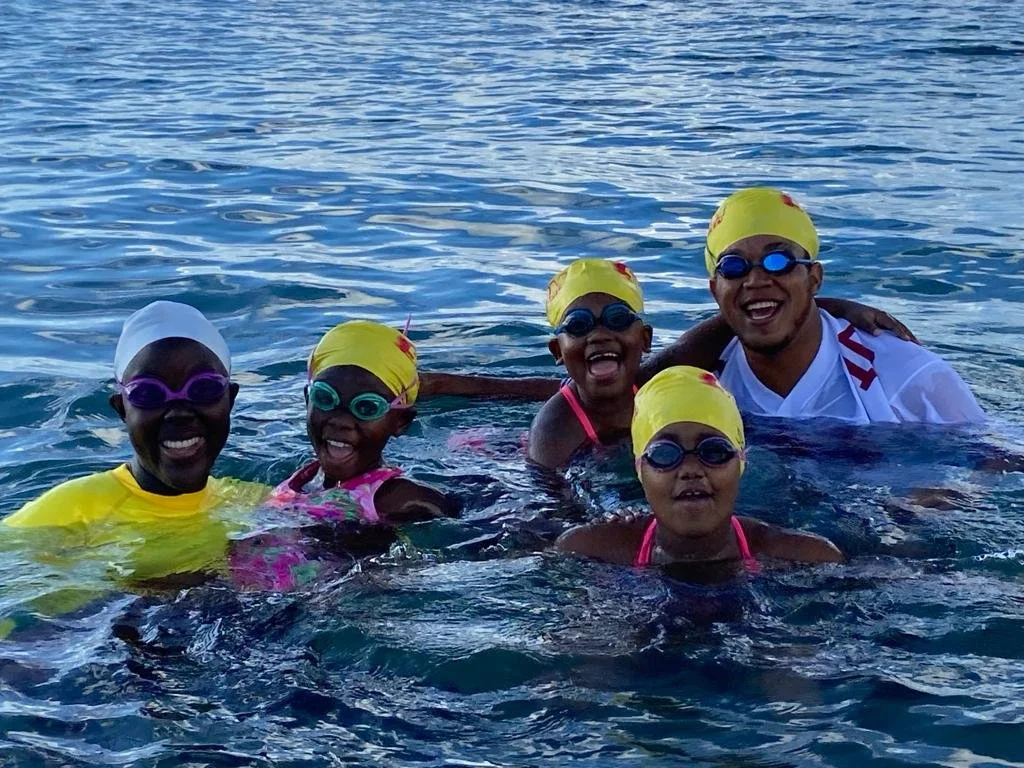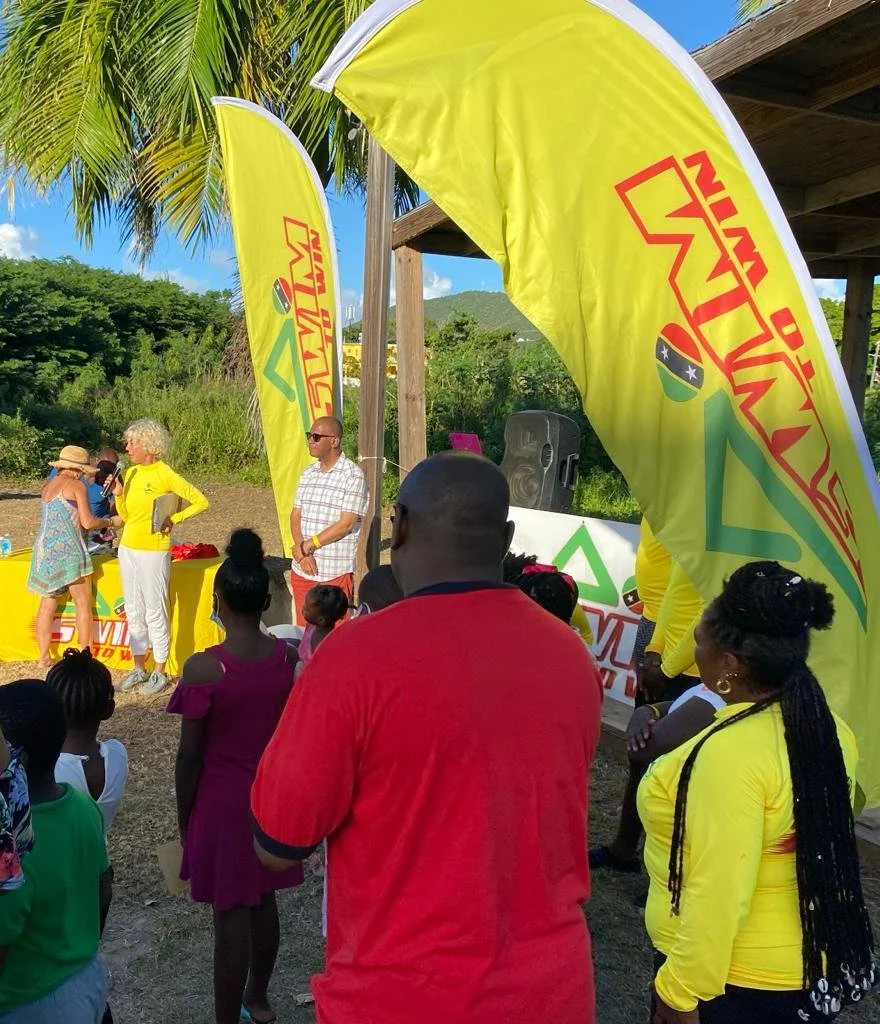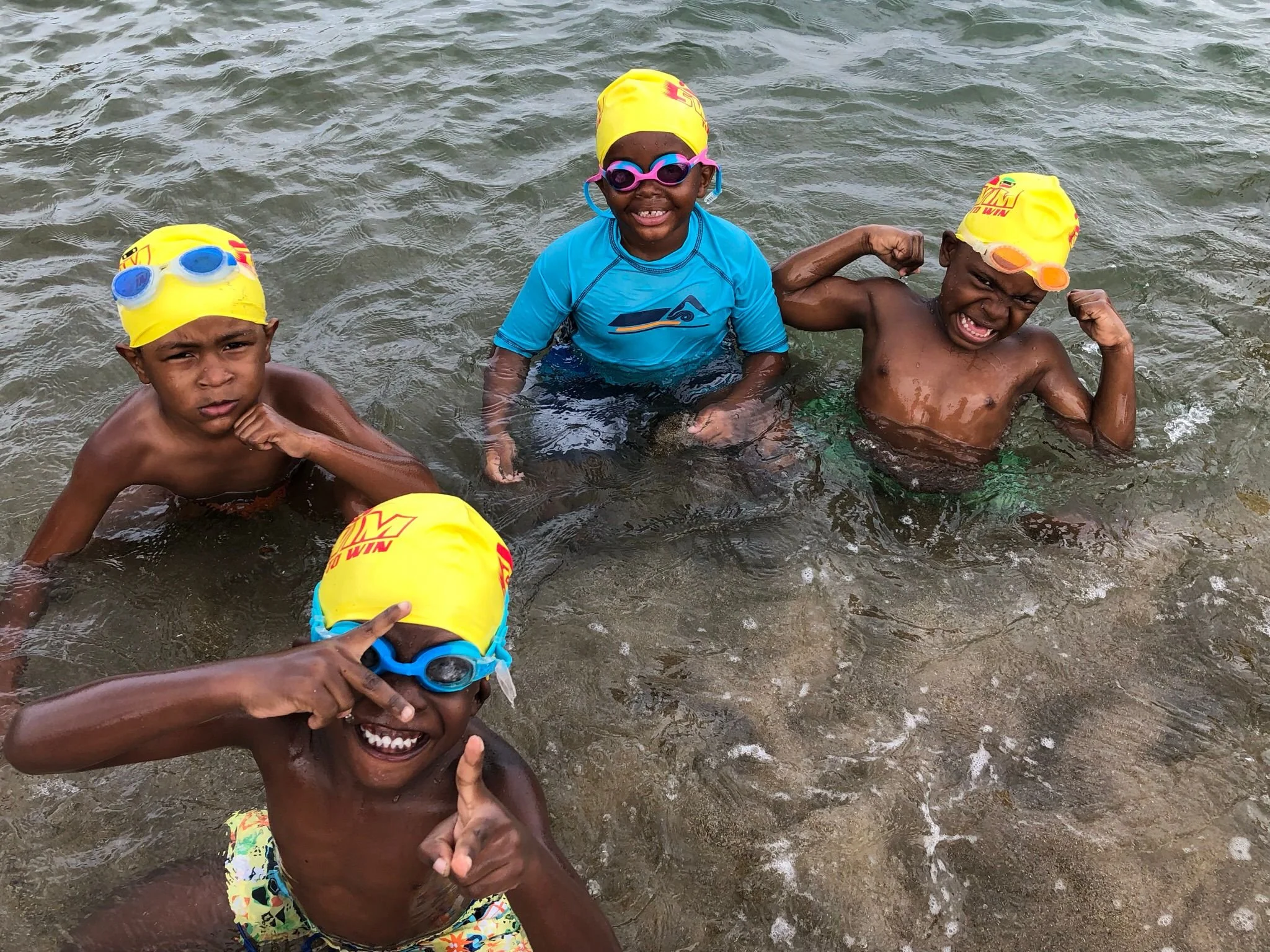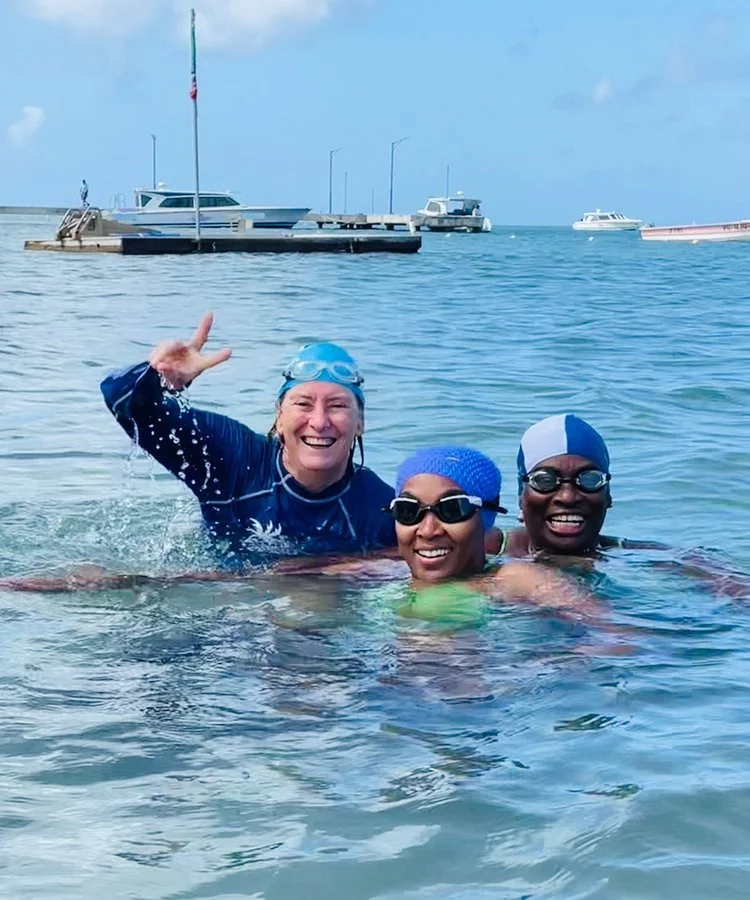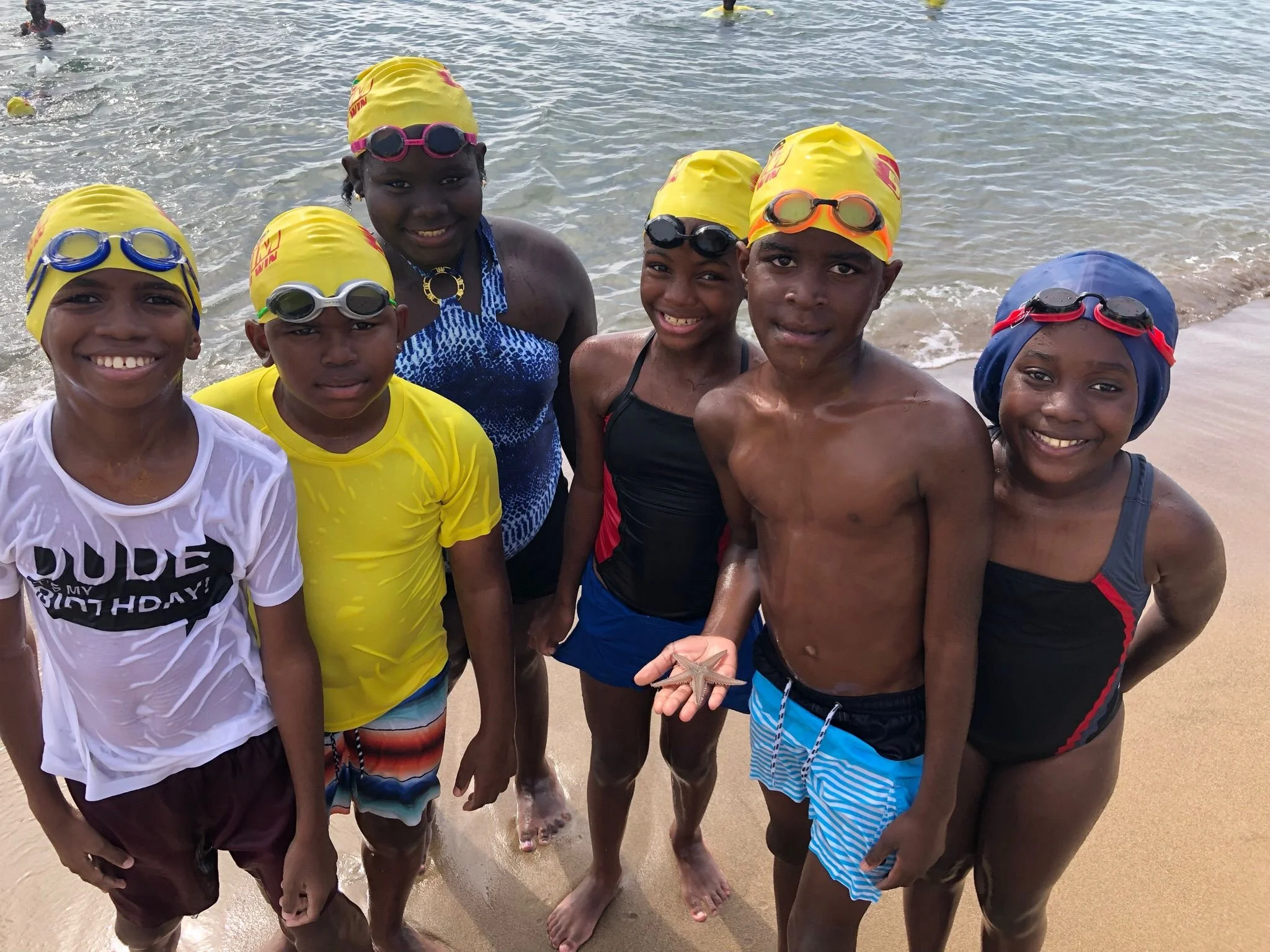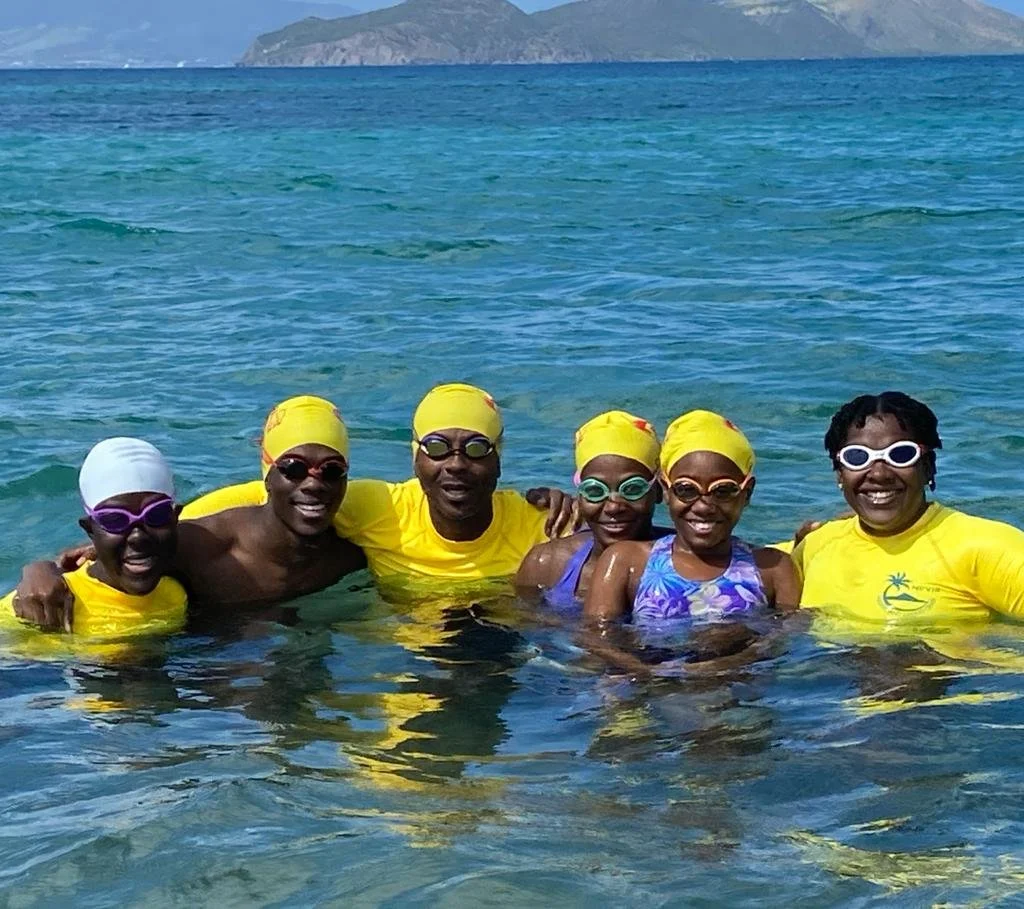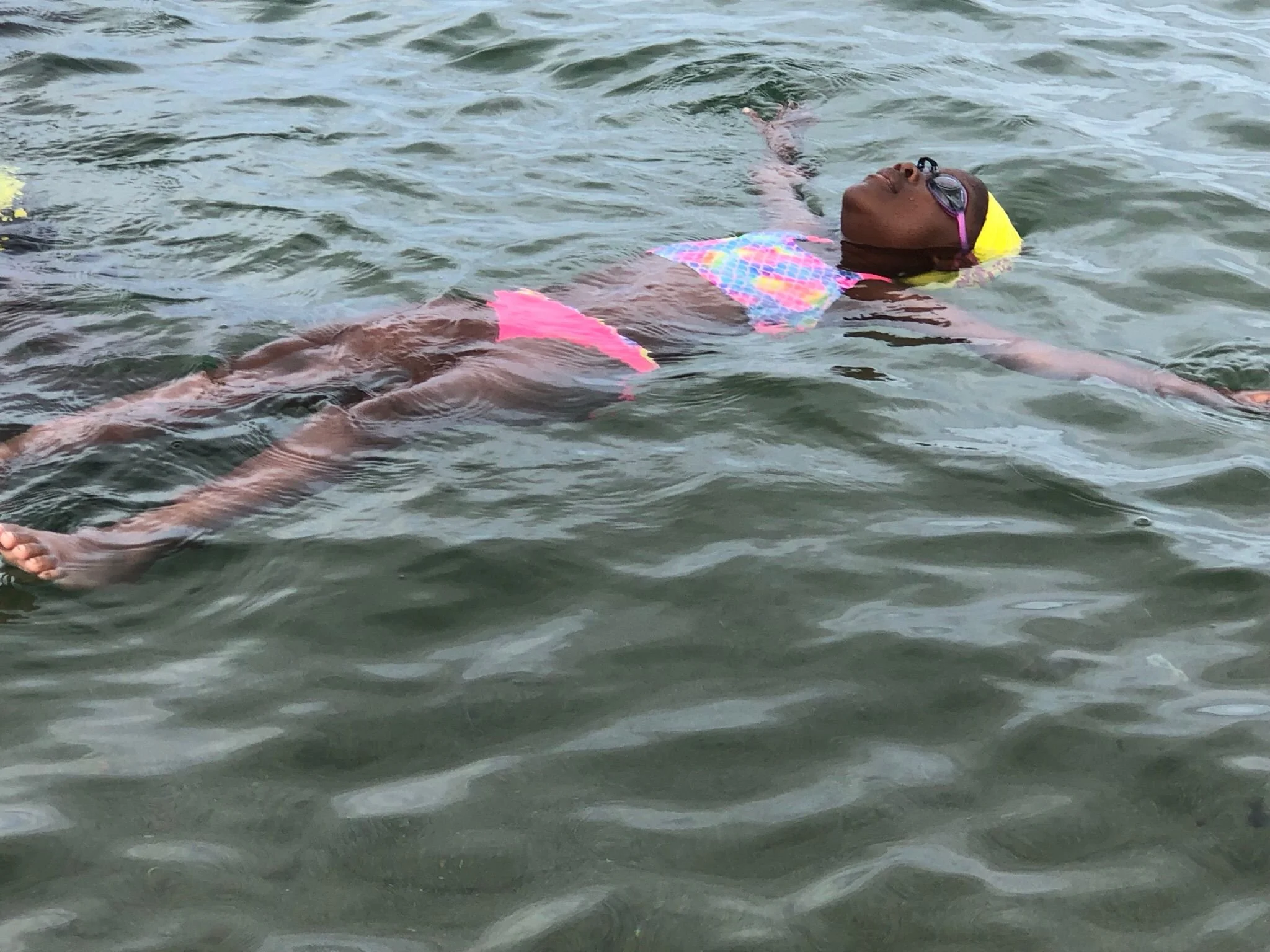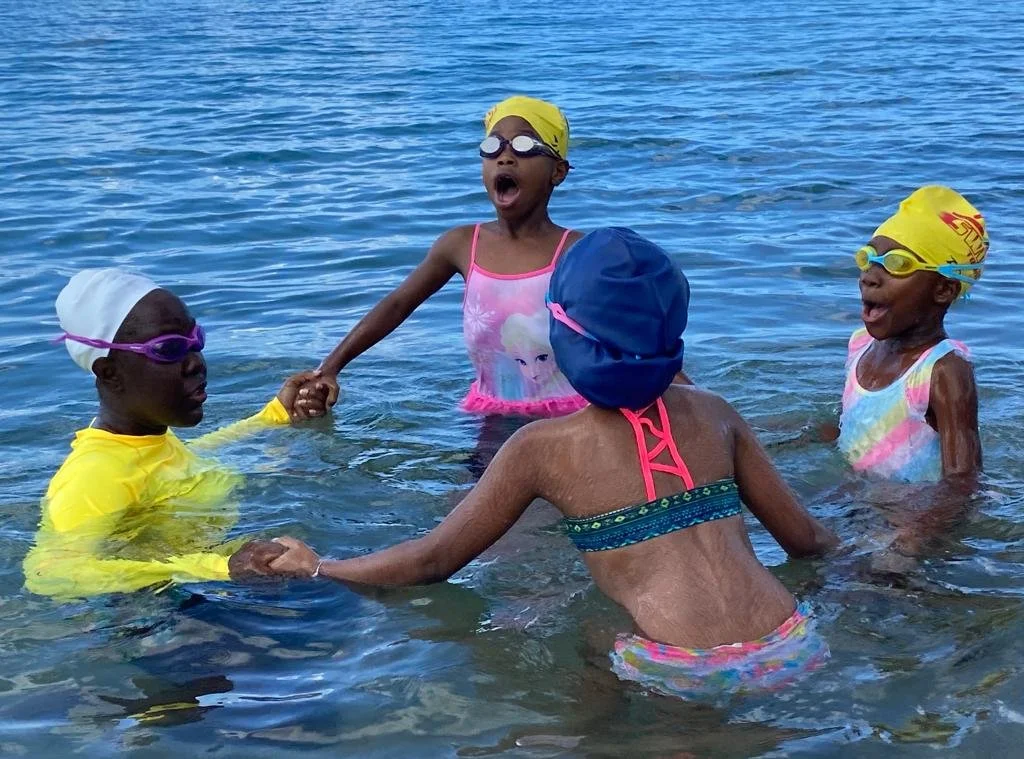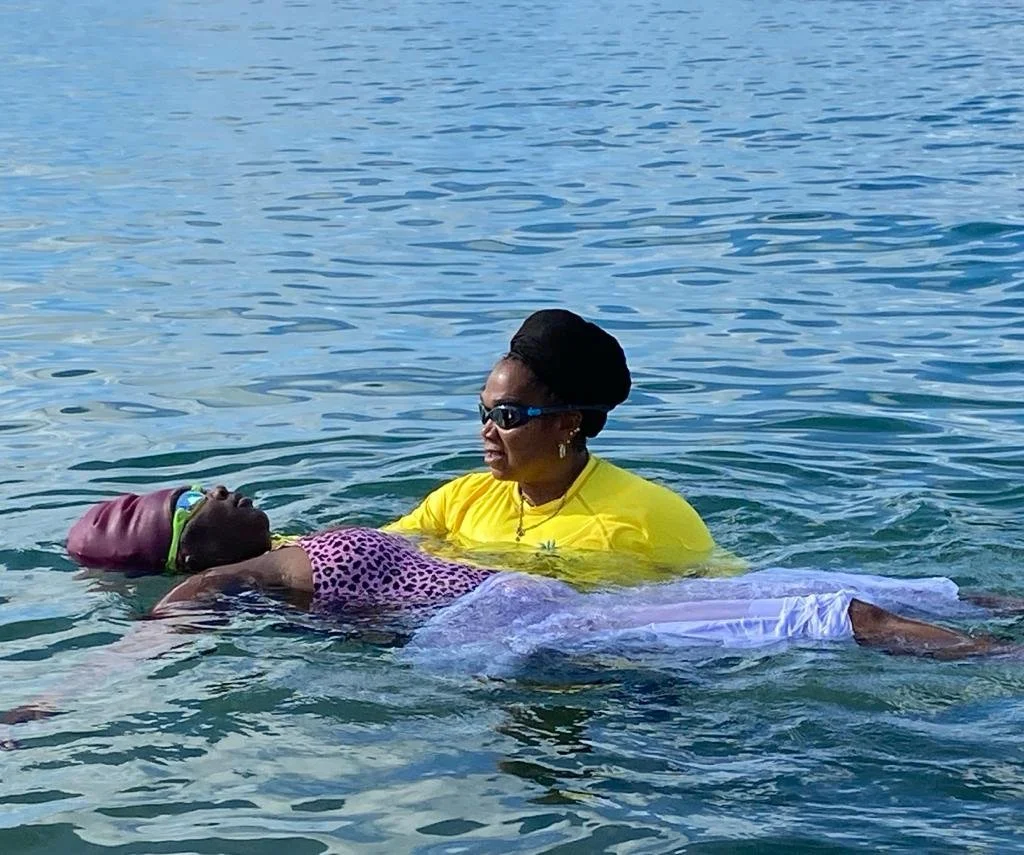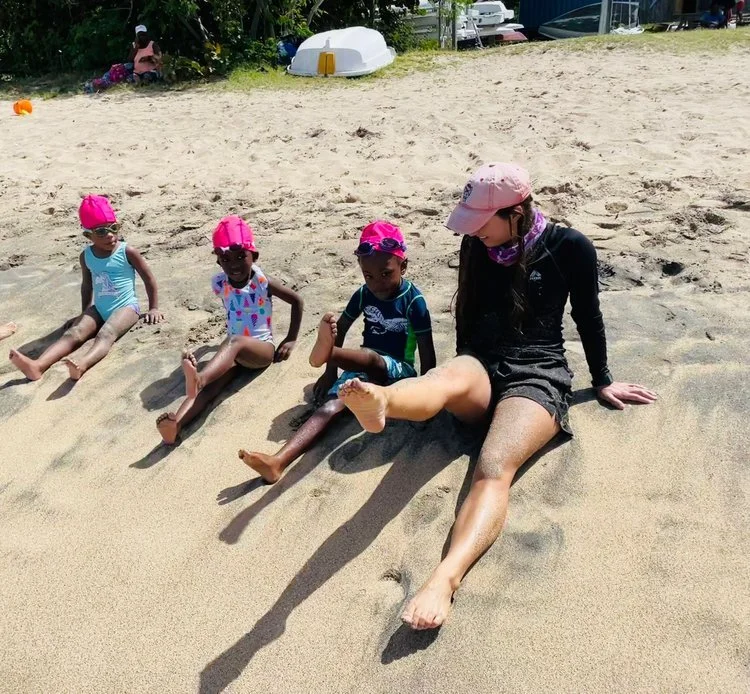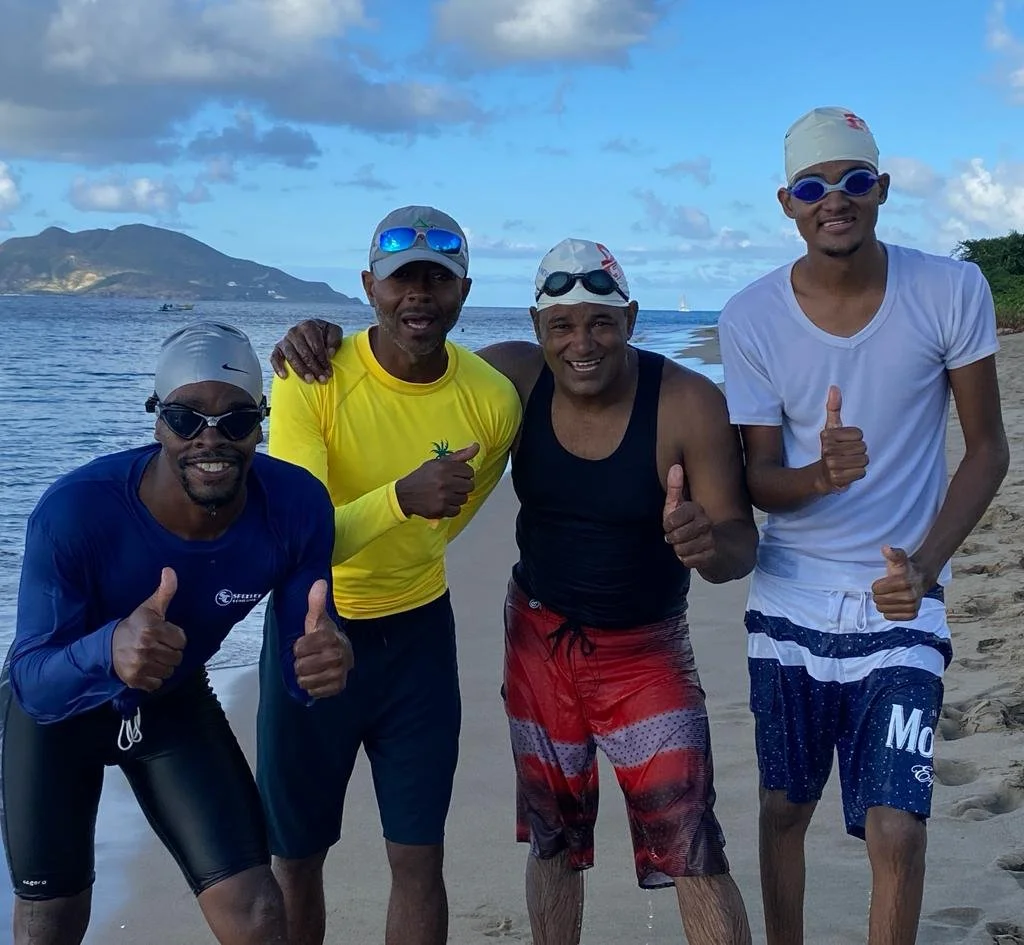Conquering 50 Years of Fear
On August 1, 1970 the lives of Nevisians changed forever when the Christena ferry sank. Now, over fifty years later, community programs offer the chance to overcome widespread fears of the ocean through swim lessons for any age.
Zahnela Claxton stands in the water up to her ankles, her whole body shaking. Sand squishes underneath her feet on the shore of Oualie Beach. The water is still, but Claxton stands paralyzed, unable to take another step farther into the water. She’s been avoiding this day for years out of fear that once she’s in the water she will sink right to the bottom. As a child she watched her friends’ fathers push them off the end of docks or the pier in Charlestown to learn how to swim. The men would stand just out of reach from their children, forcing them to swim back to shore through their tears and panic. Even her mother had been tossed into the water as a child. While the tactic worked for some, it terrified many others. For Claxton the water surrounding the island became something to fear rather than to conquer. But now, at the age of 39, she is finally ready to overcome it.
Since almost the entire perimeter of the 36-square-mile island of Nevis is covered with beaches, it’s easy to assume that every Nevisian knows how to swim. But that isn’t the reality. Instead, many people on the island are plagued by a deep-seated fear of the ocean. The irony of living on an island and not knowing how to swim stems from cultural and historical fears among Black Nevisians, who make up the majority of the island’s population. There are also specific histories on the island, including the 1970 sinking of the Christena ferry that influenced Nevisians’ attitudes toward swimming (if you are unfamiliar with the tragedy, see The Story of the Sinking Christena for a brief history). Everyone knew someone who died on August 1st, 1970, and the avoidable tragedy impacted Nevisian families for decades to come. While the fear of the ocean existed long before the Christena sinking, the incident became the face for the fear of water that confronts many Nevisians daily, including Claxton. Instead of learning to swim in the wake of the tragedy, many people used the Christena as further justification to avoid the water.
But now, 50 years later, there are finally programs on the island to teach Nevisians of all ages how to swim. The charge for swim education is being led by the Swim to Win program and the Nevis Aquatic and Sailing Center (NASC). Both groups lead teams of paid instructors and volunteers to teach people from age 5 to 95 how to swim in weekly lessons. There have been others who tried to teach small-group, private swimming lessons in the past, but the lessons were often unstructured or the instructors were unreliable. There has never been a concerted, long-lasting effort for swim education on the island until now. The current programs emphasize the importance of consistency in learning how to swim, both for the instructors running the lessons and students who must show up every week. Swim to Win and NASC arm their students with both the physical skills necessary to save themselves in the water and the mental tools to make swimming fun. After years of a community-wide inability to face the trauma of the Christena tragedy, hundreds of Nevisians are finally exploring the water for the first time through these programs.
Historically, the Black community faces a challenging relationship with water. Millions of people were forced out of their homelands and into treacherous ocean journeys on slave ships. The ocean came to represent a place of turmoil and trauma after so many people were lost to the horrors of the slave trade. These histories shape many Black peoples’ experiences with water to this day. Black communities also had to endure systemic racism that barred them from the water. In the U.S., pools and public swimming areas were completely inaccessible for years. It wasn’t until the summer of 1950 that swimming pools were finally desegregated. And despite legally being desegregated, de facto segregation continued in many places. This pattern of exclusion extends into athletics, as there are very few professional Black swimmers at the Olympic level or even regionally. The Guardian recently published a piece examining the phenomenon, coining the term “Bl-aquaphobia,” which describes the inherent fear that Black people have of water and how it differs from white people’s fears, which typically stem from individual experiences.
These trends are visible across the Caribbean as well. Winston Crooke, head of the St. Kitts and Nevis Swimming Federation, has traveled the world as a triathlete and coach. He says that while there is a general mistrust of the ocean across the Caribbean, nowhere quite compares to Nevis. During his 30-plus years living on the island, Crooke says you’d rarely see locals swimming in the ocean, and if you did people were only in the water up to their knees, as they didn’t know how to swim. When traveling around the island the shores of some beaches are completely empty, due in part to the societal distrust of the ocean. Claxton’s own experience reflects this, as before she conquered her fear of the water she hadn’t stepped foot on a beach in over 15 years.
Terri Andrews, who has traveled extensively throughout the Caribbean, also saw this pattern across Nevis when she first began visiting. She says on other Caribbean islands there were always more kids and adults swimming and splashing in the water than on Nevis. The intensity of fear surrounding the ocean on Nevis is due largely in part to the Christena tragedy of August 1, 1970, when the daily ferry between the sister islands of St. Kitts and Nevis sank after the boat was severely overcrowded. Ultimately 230 people died in the sinking of the Christena, 194 of them from Nevis and the rest from St. Kitts, the larger of the two islands. At the time, Nevis had a population of only around 6,000 people. That means in a single day Nevis lost roughly 3% of its population. There were mothers lost with their children. There were household breadwinners lost. There were community leaders lost. The entire island of Nevis was rocked to its core by the tragedy, and the effects were felt for decades. Claxton says the trauma was passed down from generation to generation, manifesting itself in a continued fear of the ocean amongst Nevisian communities and within her own family.
The simple yet terrible reason for the accident boils down to negligence. Steve Manners, a well-respected community historian, says government negligence was pervasive in 1970. The British government gifted the Christena to St. Kitts and Nevis in the 1950s after building it in nearby Guyana. But the boat should never have touched ocean water, as its flat bottom meant it was suitable only for cruising through rivers. The government accepted the boat anyway. Engineers who performed maintenance on the boat each Thursday alerted the administration that the boat was taking on more water than usual, but the boat continued to go to sea. Also, there were never any lawsuits to bring justice to the victims’ families or to survivors of the tragedy. With only two lawyers on Nevis at the time, both of whom worked for the government, there was no one to act as a representative, and families were left affected emotionally and financially for decades to come. “It caused a huge vacuum in people’s lives,” Manners says.
James Weeks, a swimming instructor whose father survived the Christena accident, agrees that the tragedy is constantly on Nevisians’ minds. He thinks the aftershocks of the tragedy scared people away from swimming rather than motivating them to learn to swim. “You cannot stay on the shore to face a fear. You have to go in and face it,” Weeks explains.
This is the main reason Terri Andrews started Swim to Win, just over 50 years after the tragedy. Andrews is an expat from California, but she’s lived full-time on Nevis for a number of years. During her first few years living on the island she became involved with the Special Olympics team, coaching the newly created open water swim event. At the time, those training for the Special Olympics were the only people actively learning proper swimming techniques. But when Andrews started to discuss the idea of swim lessons for all ages she met immediate resistance. “You would talk to people, locals, about swimming and they would physically back up from me in fear,” Andrews says.
Anne McClindon helps teach a young girl how to swim, which is her favorite part of being involved with Swim to Win. | Photo Courtesy of Anne McClindon
Despite the hesitation, Andrews began planning the Swim to Win program in early 2019 with the help of Crooke, who had well-established relationships within the small swim community that did exist. Andrews wanted to teach people to swim and create opportunities for kids to participate in swimming as a sport. She hired her friend Anne McClindon as curriculum developer, as McClindon spent decades as swimming coach and judge for the Special Olympics. McClindon trains all the instructors on a set of physical techniques, getting right into the water with them during each session. Once the instructors have the technique down, she teaches them how to address students’ fear. She explains that there is a heightened fear when learning to swim in the ocean because it’s such a dynamic environment, but she tries to mitigate this by making people feel comfortable before they even step foot into the water. “It’s not about eliminating fear. It’s about how we work with that person and their level of fear to manage it. Fear is a very natural feeling that we all have experienced. The worst thing we can do is minimize that,” McClindon says. It is this approach that eventually got Claxton into the water.
Terri Andrews (middle right) sits with a group of young students just learning how to swim. Some of the children’s first lessons are given in a small pool to acclimate them to water. | Photo Courtesy of Terri Andrews
The Swim to Win program officially started in October 2019. While the immediate focus of the program was to teach new generations of children how to swim, it was important to Andrews to offer adult lessons as well. Many adults on the island still remember the Christena, and some lost family members in the accident, meaning they are far more afraid to conquer the water than most children. From October 2019 to October 2020 120 people learned how to swim through the Swim to Win program, despite the start of the COVID-19 pandemic in March 2020, which closed Nevis’s borders. Andrews says the pandemic motivated people to come out for lessons simply because they wanted human interaction. In late 2020 NASC also started a swim program and have experienced great success since, as many children who began swimming through the program are now also learning how to sail.
Danielle O’Connor, chairperson for NASC, attributes much of the program’s success to the fact that children on Nevis no longer have direct ties with the tragedy. She believes children are less inherently fearful of the ocean, making it easier for them to take that first step into the water. However, parents often pass down their own fears to their children, which complicates the learning process. Elias Lee, the swim program coordinator for NASC, says he often has parents sitting on the shore in total panic while he tries to teach their children to swim. After raising his children in Atlanta, Georgia, Lee decided to move to Nevis to become part of a closer community. When he arrived he saw how Nevisian kids wanted to swim but were held back – both physically and mentally – by their parents. Now Lee’s main mission as an instructor is to break this cycle of fear that stems from parents. “Yes, kids learn with consistency. But without parents you’re never even going to get there. It’s about being safe, being secure, and saving yourself,” Lee says.
Weeks, who also works with NASC, approaches teaching with the same outlook. As a triathlete, he’s competed in countless races, and he attributes his success to his mental coaching even more than the physical training. He says it’s important to equip yourself with the mental fortitude and stamina to push through both fear and hesitation when becoming a better athlete. He applies this philosophy to his students, both those who are just learning to swim and others who have become skilled swimmers. “What we are doing is breaking the cycle [of fear]. I want them to feel they are invincible,” Weeks says. He beams with pride whenever he talks about the kids he coaches. Currently Weeks teaches around 15 strong swimmers, a number that would have been inconceivable for Nevis even five years ago. One student, Abhijith Srinivasan, even competed in the Peninsula Swim, a three-kilometer open swim race, at 6 years old.
James Weeks, a coach for NASC, with two of his students after completing a race. | Photo Courtesy of James Weeks
Claxton, who works as the Principal Education Officer for the Nevis Island Administration, first found out about the programs when her niece was signed up for lessons. She saw firsthand how the instructors helped children by understanding how they were influenced by the anxieties and teachings of their parents. “It’s a part of our history, but it’s not a part of their recent memory,” she says. Through these observations and as the leader of the entire school system on the island, Claxton saw the benefits of the programs for children. She began collaborating with other government ministers and Andrews to create a pilot program that integrates swimming lessons into physical education classes for three schools on the island. Watching the success of her niece and other children made Claxton start to realize that the programs could benefit more than just children. They could also benefit someone like her.
The push for swim education is particularly important for women like Claxton, especially in the wake of the Christena. Only 8 of the 91 people who survived that day were women, even though there were far more female passengers than male. The boat was filled with mothers, daughters, and grandmothers from the community, yet almost none of them knew how to swim. Now these legacies are being broken, as it’s mostly women in their late twenties to mid-forties who are signing up for adult lessons.
Gayle Jeffers, a Nevis national currently getting her Ph.D. in the U.S., is one of these women. She’s experienced major anxiety about swimming ever since slipping under the water in a pool while briefly living in Connecticut as a child. While Jeffers, who is in her 30s, was not alive when the Christena sank, her parents were deeply affected by the tragedy since they had both friends and family on the boat. As a child and throughout high school Jeffers was never allowed to go to the beach without her parents. If she ever wanted to go with friends her father would lurk in the brush along the beaches’ edge to make sure nothing happened to her. Eventually the combination of a desire to conquer her fear and being forced to stay on-island during pandemic lockdowns made Jeffers sign up for lessons.
Gayle Jeffers (middle left) and Zahnela Claxton (middle right) at Yachtsman Beach after a Swim to Win lesson. | Photo Courtesy of Terri Andrews
Jeffers thought it would be best to learn to swim with a friend rather than a whole group of people, so she signed up for a six-week session of private lessons with Claxton. The pair had been friends for years and attended college together in Texas. While Claxton was very nervous to learn to swim like Jeffers, she would face an additional challenge: saltwater damages her hair. Claxton and many other women on Nevis get their hair permed or relaxed, leading to potential tangling and frizz when their hair gets wet. As a professional woman, it is important to Claxton that her hair reflects the significance of her government job; she would need to go to the hair salon weekly after swim lessons, which was both inconvenient and expensive. After listening to the womens’ struggles, Swim to Win and NASC both bought larger swim caps that fit protective hairstyles and began offering week-long lesson sessions, so women only have to go to a salon once at the end of the program.
Phaedra Grant, a 36-year-old Nevisian woman who’s in the process of completing the Swim to Win program, shares similar motivations for taking the lessons as Claxton and Jeffers. She became involved with the program when she brought her niece to lessons and realized if a young girl could get into the water she needed to as well. Most of her friends growing up could not swim. Now, even at 36, most of them still cannot swim, but many of them are starting to sign up for swim lessons. Claxton, Jeffers, and Grant’s experiences show the importance of having these programs to change the narrative of fear about the ocean that Nevisian women face daily.
After seeing the success of other women and months of watching from afar, Claxton realized she was finally ready to change her own narrative about the ocean. With the help of McClindon, Claxton took her first step into the water. And then she took another. Easing into the water, she moved toward McClindon. Claxton held on to McClindon as they waded deeper into the bay. She still felt nervous, but McClindon reassured her the water would support her entire body if she let herself relax. Claxton could feel McClindon’s hands supporting her back, yet her body stayed rigid in fear. But with McClindon’s gentle encouragement Claxton’s body slowly began to rise toward the surface of the water. Soon her arms and legs floated up through the water and stretched out at her sides. The tension in her body dissipated as she rested on her back. She embraced the warmth of the water around her and the scent of the salted air. Then McClindon took her hands out from under Claxton’s body. Without even realizing it, Claxton was floating on her own. And soon after she’d be swimming, too.
